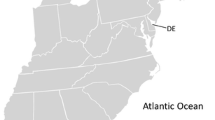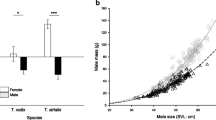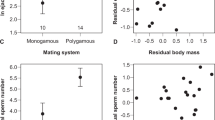Abstract
Many reproductive traits, including ejaculate characteristics, usually show remarkable seasonal variation, but the potential for such dynamics in sperm morphology has been overlooked. Several studies have revealed high within-male repeatability in sperm morphology, but samples have typically been collected within a few hours or days, and the consistency of sperm morphology over longer periods remains unexplored. Here, we tested whether ejaculate traits, including sperm morphology, sperm number, and sperm velocity, exhibit seasonal phenotypic plasticity in a long-lived seasonal breeder, the red-winged blackbird (Agelaius phoeniceus). We found absolute and/or relative flagellum length and sperm velocity to increase across the season, whereas sperm numbers within ejaculates declined. Sperm morphological traits were further positively associated with harem size or the total number of offspring that fledged in each male’s territory, suggesting that sperm morphology is likely to be linked to male reproductive quality. The underlying mechanisms of these patterns of seasonal variation remain unresolved, but we discuss our results in the context of dynamics of reproductive hormones, testicular structures and function, and reproductive behavior.


Similar content being viewed by others
References
Beletsky L (1996) The red-winged blackbird. The biology of a strongly polygynous songbird. Academic, London
Beletsky LD, Orians GH, Wingfield JC (1989) Relationships of steroid hormones and polygyny to territorial status, breeding experience, and reproductive success in male red-winged blackbirds. Auk 106:107–117
Birkhead TR, Fletcher F (1995) Male phenotype and ejaculate quality in the zebra finch Taeniopygia guttata. Proc R Soc Lond B 262:329–334
Birkhead TR, Martínez JG, Burke T, Froman DP (1999) Sperm mobility determines the outcome of sperm competition in the domestic fowl. Proc R Soc Lond B 266:1759–1764
Birkhead TR, Pellatt EJ, Brekke P, Yeates R, Castillo-Juarez H (2005) Genetic effects on sperm design in the zebra finch. Nature 434:383–387
Boschetto C, Gasparini C, Pilastro A (2011) Sperm number and velocity affect sperm competition success in the guppy (Poecilia reticulata). Behav Ecol Sociobiol 65:813–821
Calhim S, Birkhead TR (2007) Testes size in birds: quality versus quantity—assumptions, errors, and estimates. Behav Ecol 18:271–275
Calhim S, Immler S, Birkhead TR (2007) Postcopulatory sexual selection is associated with reduced variation in sperm morphology. PLoS One 2:e413
Calhim S, Double MC, Magraf N, Birkhead TR, Cockburn A (2011) Maintenance of sperm variation in a highly promiscuous wild bird. PLoS One 6:e28809
Cardullo RA, Baltz JM (1991) Metabolic regulation in mammalian sperm: mitochondrial volume determines sperm length and flagellar beat frequency. Cell Motil Cytoskelet 19:180–188
Clulow J, Jones RC (1982) Production, transport, maturation, storage and survival of spermatozoa in the male Japanese quail, Coturnix coturnix. J Reprod Fertil 64:259–266
Cohen J (1977) Reproduction. Butterworths, London
Cornwallis CK, O’Connor EA (2009) Sperm: seminal fluid interactions and the adjustment of sperm quality in relation to female attractiveness. Proc R Soc Lond B 276:3467–3475
Cramer ERA, Laskemoen T, Kleven O, Lifjeld JT (2012) Sperm length variation in house wrens Troglodytes aedon. J Ornithol. In press, doi:10.1007/s10336-012-0878-3
Crean AJ, Marshall DJ (2008) Gamete plasticity in a broadcast spawning marine invertebrate. P Natl Acad Sci USA 105:13508–13513
de Reviers M (1988) Appareil génital mâle et production des spermatozoïdes. In: Sauveur B (ed) Reproduction des Volailles et Production d'Oeufs. INRA, Paris, pp 141–181
Denk AG, Holzmann A, Peters A, Vermeirssen ELM, Kempenaers B (2005) Paternity in mallards: effects of sperm quality and female sperm selection for inbreeding avoidance. Behav Ecol 16:825–833
Dobler R, Hosken DJ (2010) Response to selection and realized heritability of sperm length in the yellow dung fly (Scathophaga stercoraria). Heredity 104:61–66
Dolbeer WA (1978) Movement and migration patterns of red-winged blackbirds: a continental overview. Bird Band 49:17–34
Dziminski MA, Roberts JD, Beveridge M, Simmons LW (2009) Sperm competitiveness in frogs: slow and steady wins the race. Proc R Soc Lond B 276:3955–3961
Farner DS, Serventy DL (1960) The timing of reproduction in birds in the arid regions of Australia. Anat Rec 137:354
Fitzpatrick JL, Montgomerie R, Desjardins JK, Stiver KA, Kolm N, Balshine S (2009) Female promiscuity promotes the evolution of faster sperm in cichlid fishes. P Natl Acad Sci USA 106:1128–1132
Gage MJG, Macfarlane CP, Yeates S, Ward RG, Searle JB, Parker GA (2004) Spermatozoal traits and sperm competition in Atlantic salmon: relative sperm velocity is the primary determinant of fertilization success. Curr Biol 14:44–47
Gasparini C, Simmons LW, Beveridge M, Evans JE (2010) Sperm swimming velocity predicts competitive fertilization success in the green swordtail Xiphophorus helleri. PLoS One 5:e12146
Gomendio M, Roldan ERS (2008) Implications of diversity in sperm size and function for sperm competition and fertility. Int J Dev Biol 52:439–447
Green K (2003) Age-related variation in mean sperm length, in the rove beetle Aleochara bilineata. J Insect Physiol 49:993–998
Harris WE, Moore AJ, Moore PJ (2007) Variation in sperm size within and between ejaculates in a cockroach. Funct Ecol 21:598–602
Helfenstein F, Szép T, Nagy Z, Kempenaers B, Wagner RH (2008) Between-male variation in sperm size, velocity and longevity in sand martins Riparia riparia. J Avian Biol 39:647–652
Helfenstein F, Podevin M, Richner H (2010) Sperm morphology, swimming velocity, and longevity in the house sparrow Passer domesticus. Behav Ecol Sociobiol 64:557–565
Higdon JJL (1979) A hydrodynamic analysis of flagellar propulsion. J Fluid Mech 90:685–711
Humphries S, Evans JP, Simmons LW (2008) Sperm competition: linking form to function. BMC Evol Biol 8:319
Immler S, Birkhead TR (2005) A non-invasive method for obtaining spermatozoa from birds. Ibis 147:827–830
Immler S, Calhim S, Birkhead TR (2008) Increased postcopulatory sexual selection reduces the intramale variation in sperm design. Evolution 62:1538–1543
Immler S, Pryke SR, Birkhead TR, Griffith SC (2010) Pronounced within-individual plasticity in sperm morphometry across social environments. Evolution 64:1634–1643
Immler S, Pitnick S, Parker GA, Durrant K, Lüpold S, Calhim S, Birkhead TR (2011) Resolving variation in the reproductive tradeoff between sperm size and number. P Natl Acad Sci USA 108:5325–5330
Immler S, Griffith SC, Zann R, Birkhead TR (2012) Intra-specific variance in sperm morphometry: a comparison between wild and domesticated zebra finches Taeniopygia guttata. Ibis 154:480–487
Jamieson BGM (2007) Avian spermatozoa: structure and phylogeny. In: Jamieson BGM (ed) Reproductive biology and phylogeny of birds, vol 6A, Science. Enfield, New Hampshire, pp 349–511
Johnsen TS (1998) Behavioural correlates of testosterone and seasonal changes of steroids in red-winged blackbirds. Anim Behav 55:957–965
Kirby JD, Froman DP (2000) Reproduction in male birds. In: Whittow GC (ed) Avian Physiology. Academic, London
Kleven O, Fossøy F, Laskemoen T, Robertson RJ, Rudolfsen G, Lifjeld JT (2009) Comparative evidence for the evolution of sperm swimming speed by sperm competition and female sperm storage duration in passerine birds. Evolution 63:2466–2473
LaMunyon CW, Ward S (2002) Evolution of larger sperm in response to experimentally increased sperm competition in Caenorhabditis elegans. Proc R Soc Lond B 269:1125–1128
Laskemoen T, Kleven O, Fossøy F, Robertson RJ, Rudolfsen G, Lifjeld JT (2010) Sperm quantity and quality effects on fertilization success in a highly promiscuous passerine, the tree swallow Tachycineta bicolor. Behav Ecol Sociobiol 64:1473–1483
Lüpold S, Calhim S, Immler S, Birkhead TR (2009a) Sperm morphology and sperm velocity in passerine birds. Proc R Soc Lond B 276:1175–1181
Lüpold S, Linz GM, Birkhead TR (2009b) Sperm design and variation in the New World blackbirds (Icteridae). Behav Ecol Sociobiol 63:899–909
Lüpold S, Linz GM, Rivers JW, Westneat DF, Birkhead TR (2009c) Sperm competition selects beyond relative testes size in birds. Evolution 63:391–402
Lüpold S, Westneat DF, Birkhead TR (2011a) Geographical variation in sperm morphology in the red-winged blackbird (Agelaius phoeniceus). Evol Ecol 25:373–390
Lüpold S, Wistuba J, Damm OS, Rivers JW, Birkhead TR (2011b) Sperm competition leads to functional adaptations in avian testes to maximize sperm quantity and quality. Reproduction 141:595–605
Lüpold S, Manier MK, Berben KS, Smith K, Daley B, Buckley SH, Belote JM, Pitnick S (2012) How multivariate ejaculate traits determine competitive fertilization success in Drosophila melanogaster. Curr Biol 22:1667–1672
Malo AF, Garde JJ, Soler AJ, Garcia AJ, Gomendio M, Roldan ERS (2005) Male fertility in natural populations of red deer is determined by sperm velocity and the proportion of normal spermatozoa. Biol Reprod 72:822–829
Martin PA, Reimers TJ, Lodge JR, Dziuk PJ (1974) Effect of ratios and numbers of spermatozoa mixed from two males on proportions of offspring. J Reprod Fertil 39:251–258
Matsuoka T, Imai H, Asakuma S, Kohno H, Fukui Y (2006) Changes of fructose concentrations in seminal plasma and glucose and testosterone concentrations in blood plasma in rams over the course of a year. J Reprod Dev 52:805–810
McDowell KJ, Little TV, Timoney PJ, Adams MH (1996) Characterisation of proteins in the seminal plasma of stallions, geldings and geldings supplemented with testosterone. Res Vet Sci 61:33–37
McLachlan RI, Wreford NG, Robertson DM, de Kretser DM (1995) Hormonal control of spermatogenesis. Trends Endocrinol Metab 6:95–101
McLachlan RI, Wreford NG, Odonnell L, de Kretser DM, Robertson DM (1996) The endocrine regulation of spermatogenesis: independent roles for testosterone and FSH. J Endocrinol 148:1–9
Miller GT, Pitnick S (2002) Sperm-female coevolution in Drosophila. Science 298:1230–1233
Morrow EH, Gage MJG (2001a) Artificial selection and heritability of sperm length in Gryllus bimaculatus. Heredity 87:356–362
Morrow EH, Gage MJG (2001b) Consistent significant variation between individual males in spermatozoal morphometry. J Zool 254:147–153
Mossman J, Slate J, Humphries S, Birkhead TR (2009) Sperm morphology and velocity are genetically co-determined in the zebra finch. Evolution 63:2730–2737
Nakagawa S, Schielzeth H (2010) Repeatability for Gaussian and non-Gaussian data: a practical guide for biologists. Biol Rev 85:935–956
Nussey DH, Wilson AJ, Brommer JE (2007) The evolutionary ecology of individual phenotypic plasticity in wild populations. J Evol Biol 20:831–844
Oppliger A, Hosken DJ, Ribi G (1998) Snail sperm production characteristics vary with sperm competition risk. Proc R Soc Lond B 265:1527–1534
Partecke J, Van't Hof T, Gwinner E (2004) Differences in the timing of reproduction between urban and forest European blackbirds (Turdus merula): result of phenotypic flexibility or genetic differences? Proc R Soc Lond B 271:1995–2001
Pellatt EJ, Birkhead TR (1994) Ejaculate size in zebra finches Taeniopygia guttata and a method for obtaining ejaculates from passerine birds. Ibis 136:97–106
Pitnick S (1996) Investment in testes and the cost of making long sperm in Drosophila. Am Nat 148:57–80
Pitnick S, Hosken DJ, Birkhead TR (2009) Sperm morphological diversity. In: Birkhead TR, Hosken DJ, Pitnick S (eds) Sperm biology: An evolutionary perspective. Elsevier, London, pp 69–149
Pizzari T, Parker GA (2009) Sperm competition and sperm phenotype. In: Birkhead TR, Hosken DJ, Pitnick S (eds) Sperm biology: An evolutionary perspective. Elsevier, London, pp 207–245
Ramm SA, Stockley P (2010) Sperm competition and sperm length influence the rate of mammalian spermatogenesis. Biol Lett 6:219–221
Robertson RJ (1973) Optimal niche space of the red-winged blackbird: spatial and temporal patterns of nesting activity and success. Ecology 54:1085–1093
Schlichting CD, Pigliucci M (1998) Phenotypic evolution: A reaction norm perspective. Sinauer, Sunderland
Searcy WA, Yasukawa K (1995) Polygyny and sexual selection in red-winged blackbirds. Princeton University Press, Princeton
Selander RK, Hauser RJ (1965) Gonadal and behavioral cycles in the great-tailed grackle. Condor 67:157–182
Simmons LW, Kotiaho JS (2002) Evolution of ejaculates: patterns of phenotypic and genotypic variation and condition dependence in sperm competition traits. Evolution 56:1622–1631
Simmons LW, Wernham J, García-González F, Kamien D (2003) Variation in paternity in the field cricket Teleogryllus oceanicus: no detectable influence of sperm numbers or sperm length. Behav Ecol 14:539–545
Sossinka R (1982) Domestication in birds. In: Farner DS, King AS, Parkes KC (eds) Avian Biology. Academic, London, pp 373–403
Stearns SC (1989) The evolutionary significance of phenotypic plasticity. Bioscience 39:436–445
van de Pol M, Wright J (2009) A simple method for distinguishing within- versus between-subject effects using mixed models. Anim Behav 77:753–758
Ward PI (2000) Sperm length is heritable and sex-linked in the yellow dung fly (Scathophaga stercoraria). J Zool 251:349–353
Westneat DF (1992) Nesting synchrony by female red-winged blackbirds: effects on predation and breeding success. Ecology 73:2284–2294
Westneat DF (1993a) Polygyny and extrapair fertilizations in eastern red-winged blackbirds (Agelaius phoeniceus). Behav Ecol 4:49–60
Westneat DF (1993b) Temporal patterns of within-pair copulations, male mate guarding, and extra-pair events in eastern red-winged blackbirds (Agelaius phoeniceus). Behaviour 124:267–290
Westneat DF (1994) To guard mates or go forage: conflicting demands affect the paternity of male red-winged blackbirds. Am Nat 144:343–354
Westneat DF, Gray EM (1998) Breeding synchrony and extrapair fertilizations in two populations of red-winged blackbirds. Behav Ecol 9:456–464
Westneat DF, McGraw LA, Fraterrigo JM, Birkhead TR, Fletcher F (1998) Patterns of courtship behavior and ejaculate characteristics in male red-winged blackbirds. Behav Ecol Sociobiol 43:161–171
Wingfield JC, Moore MC (1987) Hormonal, social and environmental factors in the reproductive biology of free-living male birds. In: Drews D (ed) Psychobiology of reproductive behavior: An evolutionary perspective. Prentice-Hall, Princeton, pp 148–175
Wolfson A (1954) Sperm storage at lower-than-body temperature outside the body cavity in some passerine birds. Science 120:68–71
Woltereck R (1909) Weitere experimentelle Untersuchungen über Artveränderung, speziell über das Wesen quantitativer Artunterschiede bei Daphniden. Verh Deutsch Zool Gesellsch 19:110–173
Woolley DM (1971) Selection for the length of the spermatozoan midpiece in the mouse. Genet Res 16:261–275
Wright PL, Wright MH (1944) Reproductive cycle of the male red-winged blackbird. Condor 46:46–59
Zann RA (1996) The zebra finch: A synthesis of field and laboratory studies. Oxford University Press, New York
Acknowledgments
We thank J. M. Fraterrigo, J. Homan, G. M. Linz, L. Reinhardt, and A. Trutsch for their help in the field and R. Montgomerie and two anonymous referees for valuable comments. SL was supported by the Janggen-Poehn Foundation, the Swiss National Science Foundation, a Sheffield University Overseas Research Student Award, a Lauff Research Award, and an NSF LTER Graduate Research Award; TRB, by a grant from the Leverhulme Trust; and DFW, by the U.S. National Science Foundation and the University of Kentucky.
Ethical standards
All fieldwork complies with the current laws of the USA, where the study was performed, and samples of all populations were collected under license of the respective authorities.
Conflict of interest
The authors declare that they have no conflict of interest.
Author information
Authors and Affiliations
Corresponding author
Additional information
Communicated by S. Pruett-Jones
Electronic supplementary material
Below is the link to the electronic supplementary material.
ESM 1
(PDF 106 kb)
Rights and permissions
About this article
Cite this article
Lüpold, S., Birkhead, T.R. & Westneat, D.F. Seasonal variation in ejaculate traits of male red-winged blackbirds (Agelaius phoeniceus). Behav Ecol Sociobiol 66, 1607–1617 (2012). https://doi.org/10.1007/s00265-012-1415-3
Received:
Revised:
Accepted:
Published:
Issue Date:
DOI: https://doi.org/10.1007/s00265-012-1415-3




